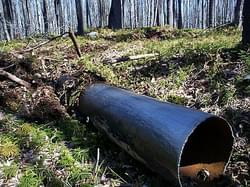




By Don A. Clymer, Trails Specialist - Allegheny National Forest, Warren, PA
The next time you need some culverts on your trail try used steel casings. You'll like them!

We trail managers spend a lot of time and energy helping water to cross our trails without softening the trail tread. A common trail crossing structure for small watercourses or intermittent streams is a culvert, which totally separates the trail use and the water.
Culverts can be made out of rocks or treated lumber, or they can be obtained already formed using corrugated metal pipe (CMP), plastic, or steel casing. This article will discuss the advantages of used steel casings as culverts on trails. The major problem with structures on our trails is getting the materials back into the location where they are needed.
We often spend as much money for transportation and labor for our structures as the materials cost. Therefore, we should be using the material that will be the easiest to transport, and will last the longest. In the world of culverts the used steel casing wins on both these points.
The lifespan of a 1/4-inch thick steel casing used as a culvert will be over fifty years in any climate or location; this is more than double the life of other culverts. To transport a steel casing down the trail our contractors often cut a small hole in the casing to catch a hook at the end of a chain. This way they can drag five or six casings at a time down the trail behind a dozer, mini excavator, or any other piece of equipment. The casings are indestructible! They can also be cut and welded into desired lengths using common acetylene torches and arc welders that most contractors have.
The price of used steel casings, when bought in truckloads, is approximately 20% more than comparable aluminized CMP culverts (market availability and prices vary). Since the steel casings are heavier the trucking costs are greater. The other advantage with used steel casings is how easy they are to set in place.
It is important to ensure that culverts are set with the bottom of the culvert in contact with the soil so the water will all flow through the culvert and not below it. A steel casing can be set by driving the equipment right on top of it to force it into good soil contact. Lighter culverts tend to move or roll out of the trench when backfilling over them. Steel casings, being heavier, are much less prone to move. A mini excavator will sometimes sit with a track holding the casing down while placing the fill over the rest of it.
You might wonder where used steel casings come from. The natural gas and oil transmission lines in our country use steel casings with plastic and tar coverings to protect the steel casing from rust and corrosion. The pipeline company tests the condition of the pipeline and when they need to be replaced the old pipeline becomes "used steel casing," usually transported in 25-foot lengths. The next time you need some culverts on your trail try used steel casings. You'll like them!
For more information on Culverts check out our article Low water stream crossings for trails and greenways.